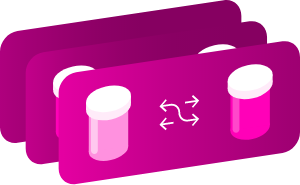Identification
- Generic Name
- Halazepam
- DrugBank Accession Number
- DB00801
- Background
-
Halazepam is abenzodiazepinederivative drug exerting anxiolytic, anticonvulsant, sedative, a muscle relaxing effects.1,2It has been shown to be less toxic than chlordiazepoxide or diazepam.1This drug is no longer marketed in the United States, and was withdrawn bySchering, its manufacturer, in 2009.3,4
- Type
- Small Molecule
- Groups
- Approved, Illicit, Withdrawn
- Structure
- Weight
-
Average: 352.738
Monoisotopic: 352.059025338 - Chemical Formula
- C17H12ClF3N2O
- Synonyms
-
- Halazépam
- Halazepam
- Halazepamum
- External IDs
-
- Sch 12041
- SCH-12041
Pharmacology
- Indication
-
Used to relieve anxiety, nervousness, and tension associated with anxiety disorders.
 Reduce drug development failure ratesBuild, train, & validate machine-learning models
Reduce drug development failure ratesBuild, train, & validate machine-learning models
with evidence-based and structured datasets.Build, train, & validate predictive machine-learning models with structured datasets. - Contraindications & Blackbox Warnings
-
 Avoid life-threatening adverse drug eventsImprove clinical decision support with information oncontraindications & blackbox warnings, population restrictions, harmful risks, & more.Avoid life-threatening adverse drug events & improve clinical decision support.
Avoid life-threatening adverse drug eventsImprove clinical decision support with information oncontraindications & blackbox warnings, population restrictions, harmful risks, & more.Avoid life-threatening adverse drug events & improve clinical decision support. - Pharmacodynamics
-
Not Available
- Mechanism of action
-
Benzodiazepines bind nonspecifically to benzodiazepine receptors BNZ1, which mediates sleep, and BNZ2, which affects affects muscle relaxation, anticonvulsant activity, motor coordination, and memory. As benzodiazepine receptors are thought to be coupled to gamma-aminobutyric acid-A (GABAA) receptors, this enhances the effects of GABA by increasing GABA affinity for the GABA receptor. Binding of GABA to the site opens the chloride channel, resulting in a hyperpolarized cell membrane that prevents further excitation of the cell.
Target Actions Organism AGABA(A) Receptor positive allosteric modulatorHumans UGABA(A) Receptor Benzodiazepine Binding Site ligandHumans - Absorption
-
Not Available
- 的体积分布
-
Not Available
- Protein binding
-
Not Available
- Metabolism
-
Hepatic.
- Route of elimination
-
Not Available
- Half-life
-
Not Available
- Clearance
-
Not Available
- Adverse Effects
-
 Improve decision support & research outcomesWith structured adverse effects data, including:blackbox warnings, adverse reactions, warning & precautions, & incidence rates.Improve decision support & research outcomes with our structured adverse effects data.
Improve decision support & research outcomesWith structured adverse effects data, including:blackbox warnings, adverse reactions, warning & precautions, & incidence rates.Improve decision support & research outcomes with our structured adverse effects data. - Toxicity
-
Not Available
- Pathways
- Not Available
- Pharmacogenomic Effects/ADRsBrowse all" title="" id="snp-actions-info" class="drug-info-popup" href="javascript:void(0);">
- Not Available
Interactions
- Drug InteractionsLearn More" title="" id="structured-interactions-info" class="drug-info-popup" href="javascript:void(0);">
-
This information should not be interpreted without the help of a healthcare provider. If you believe you are experiencing an interaction, contact a healthcare provider immediately. The absence of an interaction does not necessarily mean no interactions exist.
Drug Interaction Integrate drug-drug
interactions in your software1,2-Benzodiazepine The risk or severity of CNS depression can be increased when Halazepam is combined with 1,2-Benzodiazepine. Acetazolamide The risk or severity of CNS depression can be increased when Halazepam is combined with Acetazolamide. Acetophenazine The risk or severity of CNS depression can be increased when Halazepam is combined with Acetophenazine. Agomelatine The risk or severity of CNS depression can be increased when Halazepam is combined with Agomelatine. Alfentanil The risk or severity of adverse effects can be increased when Alfentanil is combined with Halazepam. Alimemazine The risk or severity of CNS depression can be increased when Halazepam is combined with Alimemazine. Almotriptan The risk or severity of CNS depression can be increased when Halazepam is combined with Almotriptan. Alosetron The risk or severity of CNS depression can be increased when Halazepam is combined with Alosetron. Alprazolam The risk or severity of CNS depression can be increased when Alprazolam is combined with Halazepam. Alverine The risk or severity of CNS depression can be increased when Halazepam is combined with Alverine.  Identify potential medication risksEasily compare up to 40 drugs with our drug interaction checker.Get severity rating, description, and management advice.Learn more
Identify potential medication risksEasily compare up to 40 drugs with our drug interaction checker.Get severity rating, description, and management advice.Learn more - Food Interactions
- Not Available
Products
-
 Drug product information from 10+ global regionsOur datasets provide approved product information including:
Drug product information from 10+ global regionsOur datasets provide approved product information including:
dosage, form, labeller, route of administration, and marketing period.Access drug product information from over 10 global regions. - International/Other Brands
- Alapryl (Menarini)/Pacinone (Schering-Plough)/Paxipam (Schering-Plough)
Categories
- ATC Codes
- N05BA13 — Halazepam
- Drug Categories
- Chemical TaxonomyProvided byClassyfire
-
- Description
- This compound belongs to the class of organic compounds known as 1,4-benzodiazepines. These are organic compounds containing a benzene ring fused to a 1,4-azepine.
- Kingdom
- Organic compounds
- Super Class
- Organoheterocyclic compounds
- Class
- Benzodiazepines
- Sub Class
- 1,4-benzodiazepines
- Direct Parent
- 1,4-benzodiazepines
- Alternative Parents
- Alpha amino acids and derivatives/Benzene and substituted derivatives/Aryl chlorides/Tertiary carboxylic acid amides/Lactams/Ketimines/Propargyl-type 1,3-dipolar organic compounds/Azacyclic compounds/Organopnictogen compounds/Organofluorides show 5 more
- Substituents
- 1,4-benzodiazepine/Alkyl fluoride/Alkyl halide/Alpha-amino acid or derivatives/Aromatic heteropolycyclic compound/Aryl chloride/Aryl halide/Azacycle/Benzenoid/Carbonyl group show 19 more
- Molecular Framework
- Aromatic heteropolycyclic compounds
- External Descriptors
- Not Available
- Affected organisms
-
- Humans and other mammals
Chemical Identifiers
- UNII
- 320YC168LF
- CAS number
- 23092-17-3
- InChI Key
- WYCLKVQLVUQKNZ-UHFFFAOYSA-N
- InChI
-
InChI=1S/C17H12ClF3N2O/c18-12-6-7-14-13(8-12)16(11-4-2-1-3-5-11)22-9-15(24)23(14)10-17(19,20)21/h1-8H,9-10H2
- IUPAC Name
-
7-chloro-5-phenyl-1-(2,2,2-trifluoroethyl)-2,3-dihydro-1H-1,4-benzodiazepin-2-one
- SMILES
-
FC(F)(F)CN1C2=C(C=C(Cl)C=C2)C(=NCC1=O)C1=CC=CC=C1
References
- Synthesis Reference
-
U.S. Patents 3,429,874 and 3,641,147.
- 一般引用
-
- Fann WE, Pitts WM, Wheless JC: Pharmacology, efficacy, and adverse effects of halazepam, a new benzodiazepine. Pharmacotherapy. 1982 Mar-Apr;2(2):72-9. [Article]
- Richards BL, Whittle SL, Buchbinder R: Muscle relaxants for pain management in rheumatoid arthritis. Cochrane Database Syst Rev. 2012 Jan 18;1:CD008922. doi: 10.1002/14651858.CD008922.pub2. [Article]
- Paxipam approval, FDA [Link]
- Federal drug register, FDA [Link]
- External Links
-
- Human Metabolome Database
- HMDB0014939
- KEGG Drug
- D00338
- PubChem Compound
- 31640
- PubChem Substance
- 46508415
- ChemSpider
- 29343
- BindingDB
- 50408018
- 26412
- ChEBI
- 5603
- ChEMBL
- CHEMBL970
- ZINC
- ZINC000000537811
- Therapeutic Targets Database
- DAP000679
- PharmGKB
- PA164746526
- Drugs.com
- Drugs.com Drug Page
- Wikipedia
- Halazepam
Clinical Trials
- Clinical TrialsLearn More" title="" id="clinical-trials-info" class="drug-info-popup" href="javascript:void(0);">
-
Phase Status Purpose Conditions Count
Pharmacoeconomics
- Manufacturers
-
- Schering corp sub schering plough corp
- Packagers
-
Not Available
- Dosage Forms
-
Form Route Strength Tablet - 价格
- Not Available
- Patents
- Not Available
Properties
- State
- Solid
- Experimental Properties
-
Property Value Source melting point (°C) 165 °C PhysProp logP 3.97 SANGSTER (1994) - Predicted Properties
-
Property Value Source Water Solubility 0.0017 mg/mL ALOGPS logP 3.52 ALOGPS logP 4.03 Chemaxon logS -5.3 ALOGPS pKa (Strongest Acidic) 18.88 Chemaxon pKa (Strongest Basic) 2.33 Chemaxon Physiological Charge 0 Chemaxon 沪元drogen Acceptor Count 2 Chemaxon 沪元drogen Donor Count 0 Chemaxon Polar Surface Area 32.67 Å2 Chemaxon Rotatable Bond Count 3 Chemaxon Refractivity 85.26米3·mol-1 Chemaxon Polarizability 31.8 Å3 Chemaxon Number of Rings 3 Chemaxon Bioavailability 1 Chemaxon Rule of Five Yes Chemaxon Ghose Filter Yes Chemaxon Veber's Rule Yes Chemaxon MDDR-like规则 No Chemaxon - Predicted ADMET Features
-
Property Value Probability Human Intestinal Absorption + 0.9952 Blood Brain Barrier + 0.9966 Caco-2 permeable + 0.6558 P-glycoprotein substrate Substrate 0.6489 P-glycoprotein inhibitor I Inhibitor 0.739 P-glycoprotein inhibitor II Inhibitor 0.6548 Renal organic cation transporter Inhibitor 0.5819 CYP450 2C9 substrate Non-substrate 0.7819 CYP450 2D6 substrate Non-substrate 0.8422 CYP450 3A4 substrate Substrate 0.7404 CYP450 1A2 substrate Inhibitor 0.776 CYP450 2C9 inhibitor Inhibitor 0.5458 CYP450 2D6 inhibitor Non-inhibitor 0.809 CYP450 2C19 inhibitor Inhibitor 0.7949 CYP450 3A4 inhibitor Inhibitor 0.5085 CYP450 inhibitory promiscuity High CYP Inhibitory Promiscuity 0.7781 Ames test Non AMES toxic 0.8369 Carcinogenicity Non-carcinogens 0.7657 Biodegradation 没有准备好可生物降解 1.0 Rat acute toxicity 1.7143 LD50, mol/kg Not applicable hERG inhibition (predictor I) Weak inhibitor 0.9836 hERG inhibition (predictor II) Inhibitor 0.5729
Spectra
- Mass Spec (NIST)
- Not Available
- Spectra
-
Spectrum Spectrum Type Splash Key Predicted GC-MS Spectrum - GC-MS Predicted GC-MS Not Available Mass Spectrum (Electron Ionization) MS splash10-0fmi-3539000000-76854e3f82279b906a7f Predicted MS/MS Spectrum - 10V, Positive (Annotated) Predicted LC-MS/MS Not Available Predicted MS/MS Spectrum - 20V, Positive (Annotated) Predicted LC-MS/MS Not Available Predicted MS/MS Spectrum - 40V, Positive (Annotated) Predicted LC-MS/MS Not Available Predicted MS/MS Spectrum - 10V, Negative (Annotated) Predicted LC-MS/MS Not Available Predicted MS/MS Spectrum - 20V, Negative (Annotated) Predicted LC-MS/MS Not Available Predicted MS/MS Spectrum - 40V, Negative (Annotated) Predicted LC-MS/MS Not Available
Targets

insights and accelerate drug research.
- Kind
- Protein group
- Organism
- Humans
- Pharmacological action
-
Yes
- Actions
-
Positive allosteric modulator
- Curator comments
- The GABA(A) receptor is pentameric (i.e. comprising 5 subunit proteins) and therefore has a multitude of potential isoforms. The above target is a collection of all possible GABA(A) subunits that may participate in the formation of the pentameric receptor and is not meant to imply direct a drug-protein interaction for each individual subunit.
- General Function
- Inhibitory extracellular ligand-gated ion channel activity
- Specific Function
- Component of the heteropentameric receptor for GABA, the major inhibitory neurotransmitter in the vertebrate brain. Functions also as histamine receptor and mediates cellular responses to histamine...
Components:
References
- Sigel E, Steinmann ME: Structure, function, and modulation of GABA(A) receptors. J Biol Chem. 2012 Nov 23;287(48):40224-31. doi: 10.1074/jbc.R112.386664. Epub 2012 Oct 4. [Article]
- Zhu S, Noviello CM, Teng J, Walsh RM Jr, Kim JJ, Hibbs RE: Structure of a human synaptic GABAA receptor. Nature. 2018 Jul;559(7712):67-72. doi: 10.1038/s41586-018-0255-3. Epub 2018 Jun 27. [Article]
- Kind
- Protein group
- Organism
- Humans
- Pharmacological action
-
Unknown
- Actions
-
Ligand
- Curator comments
- Benzodiazepines modulate GABA(A) function by binding at the interface between alpha (α) and gamma (γ) subunits. Of the 6 α-subunits, only 4 (α-1, -2, -3, and -5) participate in the formation of this binding site. The above target is a collection of all α- and γ-subunits that are known to participate in the formation of the benzodiazepine binding site.
- General Function
- Inhibitory extracellular ligand-gated ion channel activity
- Specific Function
- Component of the heteropentameric receptor for GABA, the major inhibitory neurotransmitter in the vertebrate brain. Functions also as histamine receptor and mediates cellular responses to histamine...
Components:
References
- Zhu S, Noviello CM, Teng J, Walsh RM Jr, Kim JJ, Hibbs RE: Structure of a human synaptic GABAA receptor. Nature. 2018 Jul;559(7712):67-72. doi: 10.1038/s41586-018-0255-3. Epub 2018 Jun 27. [Article]
- Sigel E, Steinmann ME: Structure, function, and modulation of GABA(A) receptors. J Biol Chem. 2012 Nov 23;287(48):40224-31. doi: 10.1074/jbc.R112.386664. Epub 2012 Oct 4. [Article]
Drug created at June 13, 2005 13:24 / Updated at March 03, 2023 17:39




